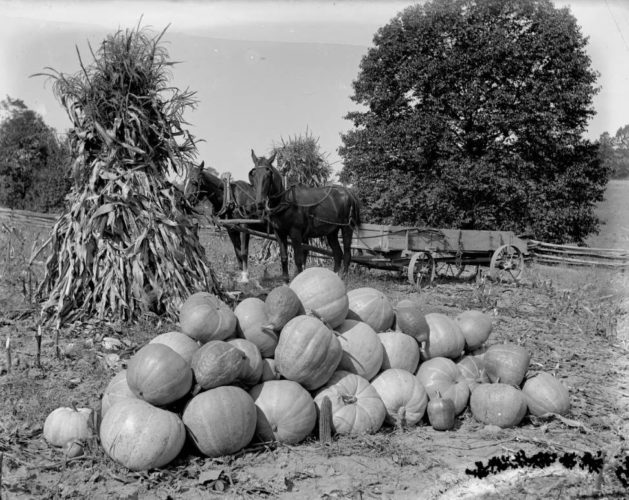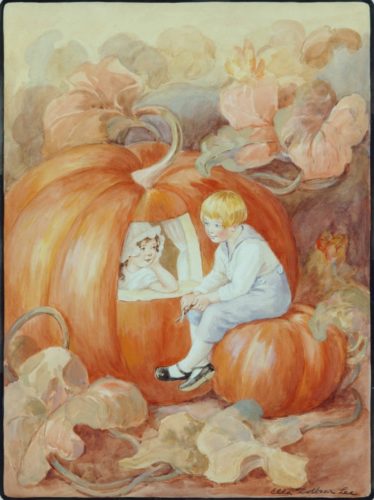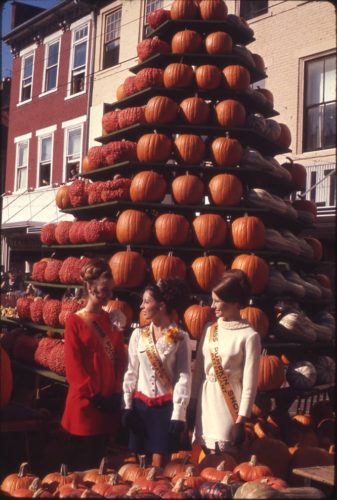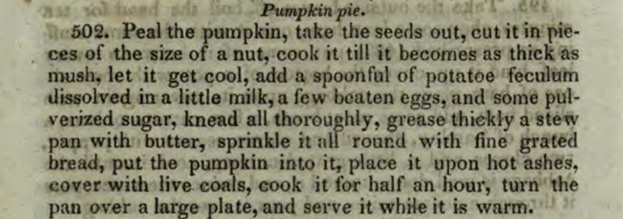Broad Spheres of Gold

“And thy life be as sweet, and its last sunset sky/ Golden-tinted and fair as thy own Pumpkin pie!” — From “The Pumpkin,” by John Greenleaf Whittier
The poet, Alfred, Lord Tennyson, wrote in Locksley Hall, “In spring a young man’s fancy lightly turns to thoughts of love.” It might also be said – with all due respect to Lord Tennyson – that in fall our fancy turns, not so lightly, to pumpkins. Pumpkins seem to be everywhere, and pumpkin spice is added to everything: coffee, cereals…kale chips???

Today, rather than continuing on the pumpkin spice bandwagon, let’s celebrate pumpkins. They’re ubiquitous this time of year, yes, but with good reason. When carved, they brighten our nights. When cooked, they are delicious and versatile. When growing in the field, they glow in the autumn sunlight. When they’re grown to a giant size, they win prizes and awe Ohioans of all ages. They even have their own festival!
Pumpkins are members of the cucurbit family, which includes cucumbers, zucchini and other summer squash, and all winter squash. They are believed to be native to the Americas, the best evidence of which is the discovery of pumpkin seeds in Mexico which, according to carbon dating, are between 8,000 and 10,000 years old (please note that the preceding link will take you to a New York Times article and is not affiliated with Ohio Memory). Pumpkins and other squash are an important part of the companion planting technique known as a Three Sisters Garden. Originated by American Indians, a Three Sisters Garden is comprised of corn, which grows to the sky; beans, which are supported by the corn and which add nitrogen (a necessary nutrient for corn and pumpkin vines) to the soil; and pumpkins or other squash, which shade the ground, suppressing weeds, and which also decrease erosion, protecting the shallow root structure of corn stalks.

As of the publication of this blog post, we are less than a week away from the 2017 Circleville Pumpkin Show. The festival is the largest event in the United States that is dedicated solely to pumpkins, and has been held every year since 1903 with just three exceptions: one year during World War I and two years during World War II. The four-day event begins the third Wednesday in October and features a pumpkin tower, rides and attractions, parades and foods. Pumpkin growers from throughout the state bring their giant pumpkins to the show in the hopes that they will be found to be the largest for the year; the current record was set in 2014 by Bob and Jo Liggett with a pumpkin weighing in at 1,964 pounds!
Miss Pumpkin is crowned annually, as is a Little Miss Pumpkin, and each year Lindsey’s Bakery makes a huge, 400-pound pumpkin pie, which sits on display for the duration of the festival, after which it becomes a welcome treat for local hogs. There are still a few more days to wait until this year’s Pumpkin Show, but these images from 1968 will give you a sense of what to expect and, probably, will have you adding the Pumpkin Show to your must-do list.
With all their versatility, pumpkins are, first and foremost, grown as a food crop. They’re simple to cook, and are excellent in both sweet and savory recipes. This December 14, 1922, issue of the Amherst News-Times provides a number of recipes for pumpkins and winter squash on page 3, while on page 19 of the January 17, 1990, issue of the Sun (published in North Canton), you will find a recipe for a pumpkin mousse ice cream pie. If you are interested in replicating historic recipes, take a look at the 1841 publication, Manual of Domestic Economy, or, House-keeper’s Guide : Comprising a Very Large Collection of Original Receipts, Derived from the Practical Experience of the Author. On page 17 you’ll find a recipe for pumpkin soup:

Meanwhile, page 84 features a recipe for pumpkin pie that requires an ingredient called “potato speculum,” which we know now as potato starch:

If you try these recipes, or if you visit the Circleville Pumpkin Show this year, or if you have any other thoughts on pumpkins and their uses, we hope you’ll share them with us. Meanwhile, happy fall, and happy pumpkin season!
Thank you to Shannon Kupfer, Digital Initiatives Librarian at theState Library of Ohio, for this week’s post!



Leave a Reply
You must be logged in to post a comment.